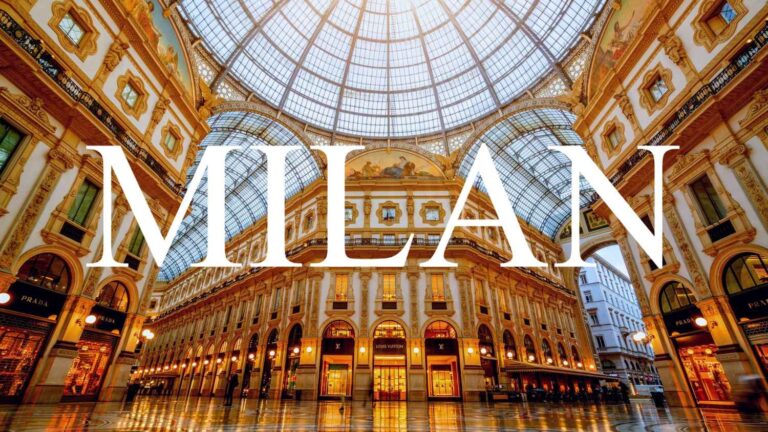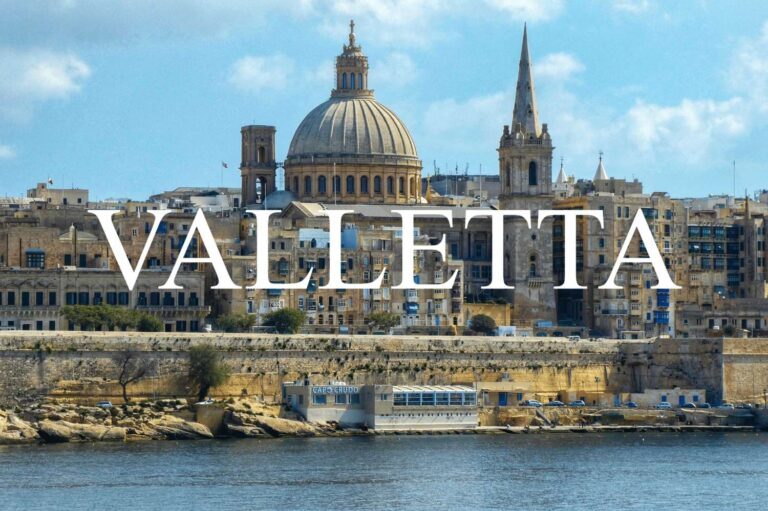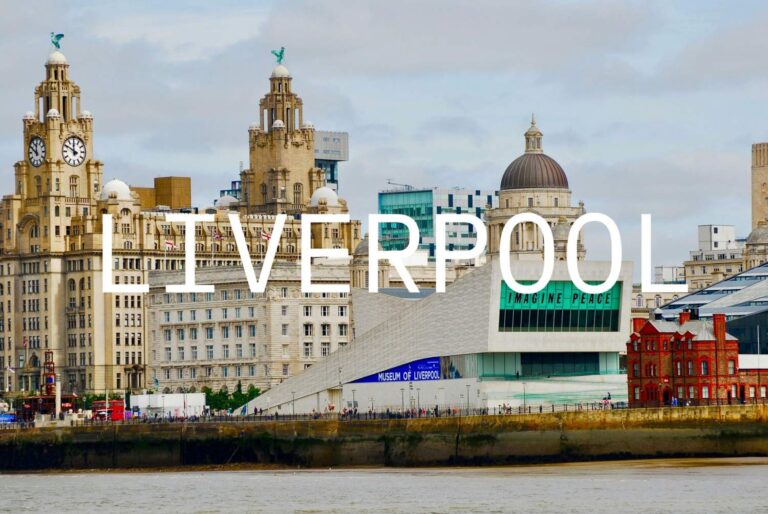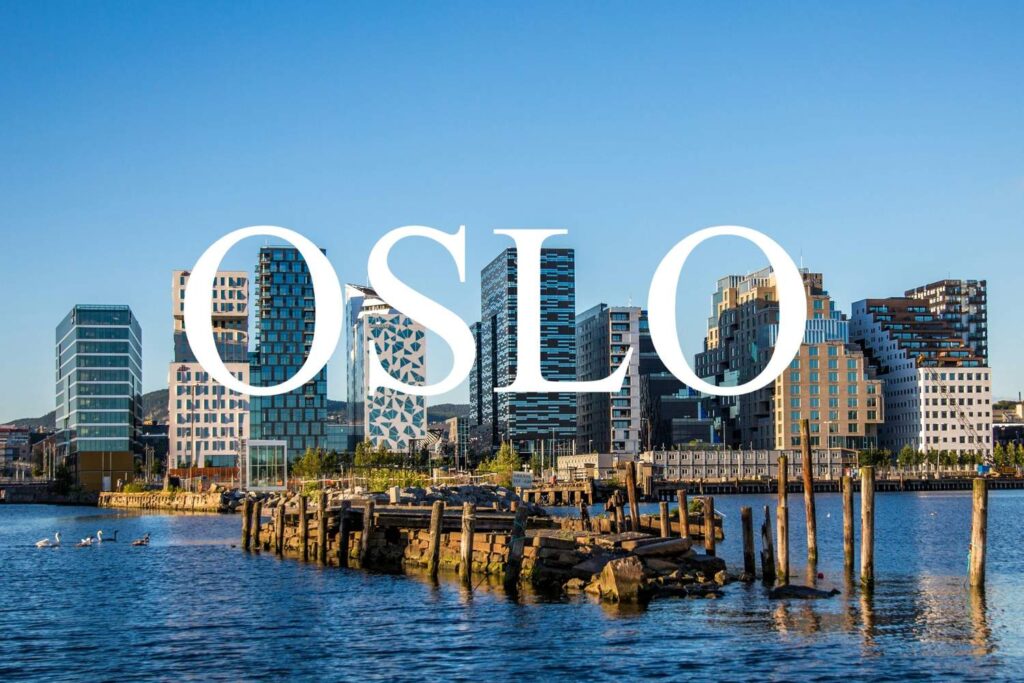
Oslo, the dynamic capital of Norway, is a city where contemporary living and breathtaking nature exist in perfect harmony. Nestled between the Oslofjord and lush forested hills, this Scandinavian gem offers an unforgettable mix of cultural richness, modern architecture, and outdoor adventure.
Wander through the sleek, waterfront Barcode district, explore the iconic Oslo Opera House, or dive into the country’s Viking past at the Fram and Viking Ship Museums. The city’s compact layout makes it easy to explore on foot or bike, with green parks, charming cafés, and world-class art galleries around every corner.
What truly sets Oslo apart is how effortlessly nature blends into everyday life. Within minutes, you can escape the urban buzz for a peaceful fjord cruise, a forest hike in Nordmarka, or skiing in winter. It’s a city made for both explorers and dreamers.
Whether you’re drawn by Nordic design, rich history, or simply the serene landscapes, Oslo offers a refreshing and authentic Scandinavian experience in every season.
🗓️ Best Time to Visit Oslo
🌞 June to August (Summer)
The best time to visit Oslo is summer, when the city enjoys long daylight hours, mild temperatures (15°C–22°C), and lively outdoor festivals. Perfect for sightseeing, fjord cruises, and hiking.
🍂 September to October (Early Autumn)
Early autumn brings crisp air and beautiful fall colors, ideal for exploring parks and cultural sites without the summer crowds.
❄️ November to March (Winter)
Winter is magical in Oslo, with opportunities for skiing, cozy cafés, and festive Christmas markets. Temperatures range from -5°C to 2°C, so pack warm clothes!
💵 Currency & Travel Essentials
- Currency: Norwegian Krone (NOK)
- Language: Norwegian (English widely spoken)
- Transportation: Efficient public transport includes trams, buses, metro (T-bane), and ferries
- Average Daily Budget:
- Budget: NOK 500–900
- Mid-range: NOK 900–1,800
- Luxury: NOK 1,800+
🏛️ 10 Best Places to Visit in Oslo
The Oslo Opera House
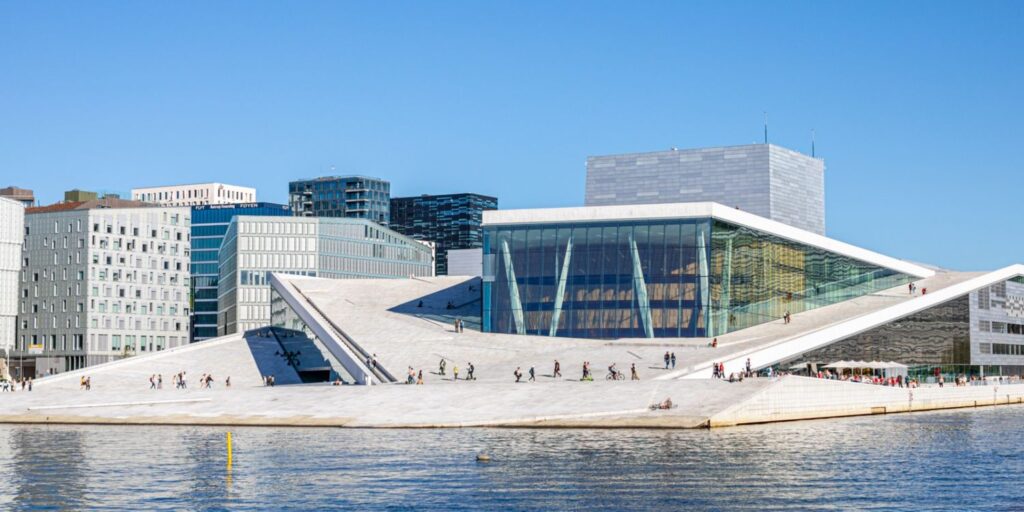
Rising majestically from the Oslofjord waterfront, the Oslo Opera House is a striking architectural masterpiece and a vibrant hub for performing arts in Norway’s capital. Known for its unique design that allows visitors to walk on its angled roof, this modern cultural landmark offers an unforgettable experience blending world-class opera, ballet performances, and breathtaking views.
🌟 Highlights of The Oslo Opera House
• 🏛️ Architectural Marvel
Designed by Snøhetta, the building’s innovative design features white marble and granite surfaces that appear to rise naturally from the fjord, inviting visitors to explore its sloping roof.
• 🎶 World-Class Performances
Enjoy a diverse program of opera, ballet, and concerts showcasing both Norwegian and international artists.
• 🌅 Panoramic Views
Climb the roof for stunning panoramic views of Oslo’s harbor, city skyline, and surrounding fjords.
• 🎨 Art and Design
Inside, discover impressive contemporary art installations and elegant interiors that reflect Norway’s rich cultural heritage.
• 📸 Photo Opportunities
The building’s striking angles and waterfront location make it one of Oslo’s most photographed landmarks.
🚗 How to Get There
• By Public Transport:
Easily reachable via Oslo Central Station (Oslo S) by foot or tram; multiple tram lines stop nearby.
• By Car or Taxi:
Accessible with parking options in the vicinity, though public transport is recommended.
🕒 Visitor Information
• Opening Hours:
Public areas and roof access are generally open daily; performance schedules vary.
• Ticketing:
Performance tickets vary by show; public access to the building and roof is free.
• Recommended Visit Duration:
Allow 1–2 hours to explore the building and possibly attend a performance.
💡 Travel Tips
• 👟 Wear Comfortable Shoes:
You’ll want to walk around the building and up the roof.
• 🎟️ Book Performances in Advance:
Popular shows can sell out quickly.
• 📷 Bring a Camera:
Capture the unique architecture and panoramic views.
• 🌤️ Check Weather:
Roof access is weather-dependent; visit on a clear day for the best experience.
The Oslo Opera House is more than just a venue for the arts — it’s a stunning architectural icon and a symbol of modern Oslo’s cultural vitality. Whether you’re a lover of performing arts or simply looking for a scenic spot, this landmark promises an enriching and memorable visit.
Vigeland Sculpture Park
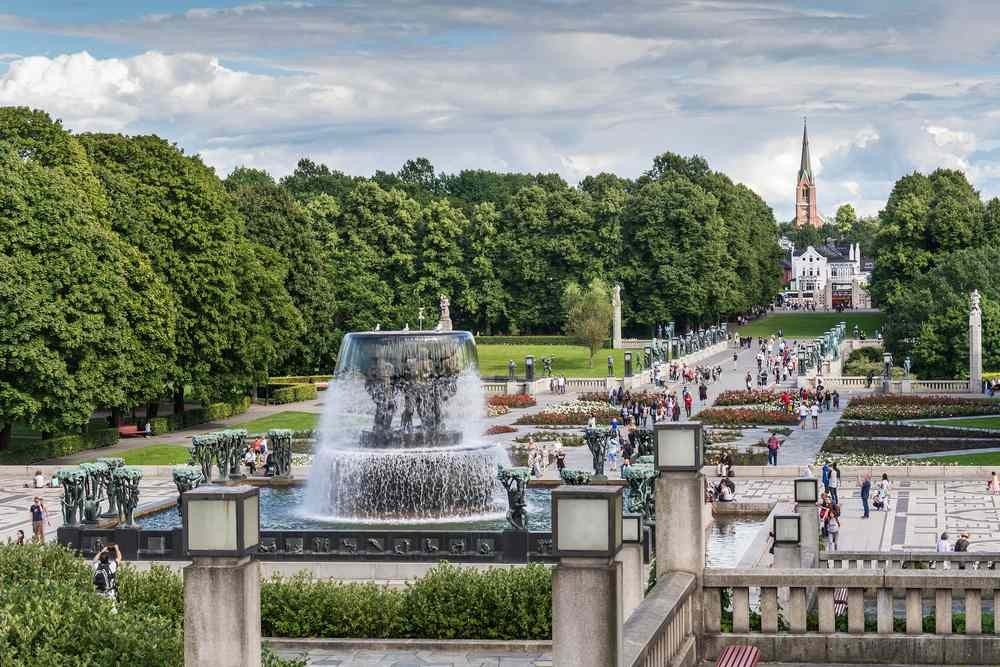
Located in the heart of Oslo’s Frogner Park, the Vigeland Sculpture Park is a breathtaking outdoor museum showcasing over 200 sculptures created by renowned Norwegian artist Gustav Vigeland. This iconic park invites visitors to stroll through beautifully landscaped gardens while admiring powerful and evocative sculptures that explore the human condition in all its forms. Whether you’re an art lover, nature enthusiast, or simply seeking a peaceful retreat, Vigeland Park offers a truly unique cultural experience.
🌟 Highlights of Vigeland Sculpture Park
• 🗿 Masterpieces by Gustav Vigeland
Discover the park’s centerpiece, the Monolith, a towering granite sculpture carved with over 100 intertwined human figures, symbolizing the cycle of life. Other notable works include the Sinnataggen (Angry Boy) and the Wheel of Life.
• 🌿 Beautifully Designed Gardens
Wander through the meticulously maintained lawns, flower beds, and tree-lined paths that create a serene atmosphere perfect for reflection and relaxation.
• 📸 Perfect Photography Spot
The striking sculptures against the natural backdrop make for stunning photos, especially during spring and summer when flowers are in full bloom.
• 🚶♂️ Accessible Walking Routes
Explore easy and well-marked trails suitable for all ages, with benches and picnic areas scattered throughout.
• 🎨 Cultural Significance
The park is not only a display of artistic talent but also a celebration of Norwegian culture and human emotions, making it a meaningful visit for all.
🚗 How to Get There
• By Public Transport:
Take tram lines 12 or 19 to the Vigeland Park stop or buses that service Frogner.
• By Taxi or Bike:
Easily reachable from central Oslo, with bike paths leading directly to the park.
🕒 Visitor Information
• Opening Hours:
Open year-round, 24 hours a day; best visited during daylight hours.
• Admission Fees:
Free entry to the park and sculptures.
• Recommended Visit Duration:
Plan 1–2 hours to fully explore the grounds and enjoy the sculptures.
💡 Travel Tips
• 👟 Wear Comfortable Shoes:
There’s plenty to explore on foot.
• 🧴 Bring Water and Sunscreen:
Especially during warm months.
• 🎒 Pack a Picnic:
Enjoy a relaxing meal on the grassy areas.
• 📅 Visit in Spring or Summer:
For the best weather and vibrant surroundings.
Vigeland Sculpture Park is a must-see cultural gem in Oslo, combining art and nature in a way that speaks to the soul. Its profound sculptures and tranquil environment make it a memorable destination for visitors of all ages, offering a peaceful and inspiring escape right within the city.
Akershus Fortress
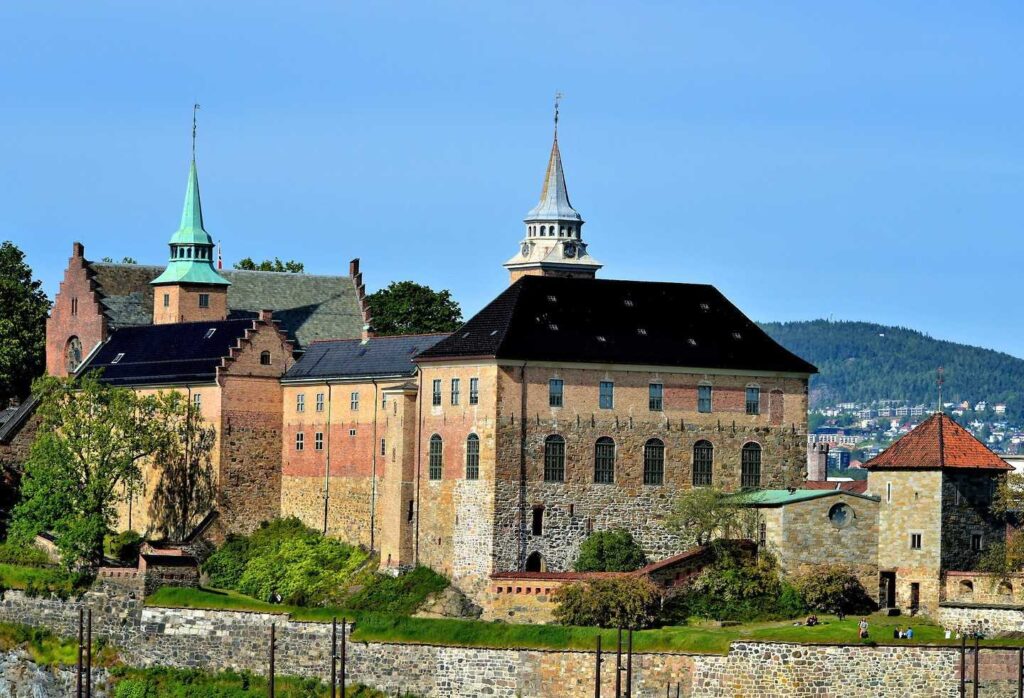
Standing proudly overlooking the Oslofjord, Akershus Fortress is a captivating medieval castle and one of Oslo’s most significant historical landmarks. Built in the late 13th century to protect the city, this fortress has witnessed centuries of Norwegian history, from royal residence to military stronghold. Today, it offers visitors a fascinating blend of history, stunning architecture, and scenic views—a must-visit for history buffs and culture lovers alike.
🌟 Highlights of Akershus Fortress
• 🏰 Medieval Architecture
Explore the fortress’s imposing stone walls, towers, and cobblestone courtyards that transport you back to Norway’s medieval past.
• 🛡️ Historical Museums
Visit the Norwegian Resistance Museum and the Armed Forces Museum housed within the fortress to learn about Norway’s military history and World War II.
• 👑 Royal Connections
Discover the fortress’s role as a royal residence and its connection to Norwegian monarchy, including the beautiful Akershus Castle Chapel.
• 🌊 Breathtaking Views
Enjoy panoramic vistas of Oslo Harbor and the fjord from the fortress walls—a perfect spot for photography and peaceful walks.
• 🎯 Events and Guided Tours
Join guided tours or attend seasonal events like medieval reenactments and cultural festivals held on the fortress grounds.
🚗 How to Get There
• By Public Transport:
Easily accessible by tram or bus to the city center; it’s a short walk from Oslo Central Station.
• By Foot:
Located near the waterfront, it’s an enjoyable walk from downtown Oslo.
🕒 Visitor Information
• Opening Hours:
Open daily, with varying hours for museums and guided tours.
• Admission Fees:
Access to the fortress grounds is free; some museums charge entrance fees.
• Recommended Visit Duration:
Plan for 2–3 hours to fully explore the fortress and its museums.
💡 Travel Tips
• 👟 Wear Comfortable Shoes:
Explore uneven cobblestones and stairs within the fortress.
• 📜 Take a Guided Tour:
Enhance your visit with historical insights from expert guides.
• 🌦️ Check the Weather:
Much of the experience is outdoors; dress accordingly.
• 📷 Bring a Camera:
Capture the fortress’s medieval charm and stunning fjord views.
Akershus Fortress is a treasure trove of Norwegian history and culture nestled in the heart of Oslo. Its majestic walls and rich stories offer visitors an immersive journey through time, making it a highlight for anyone exploring the Norwegian capital.
Fram Museum
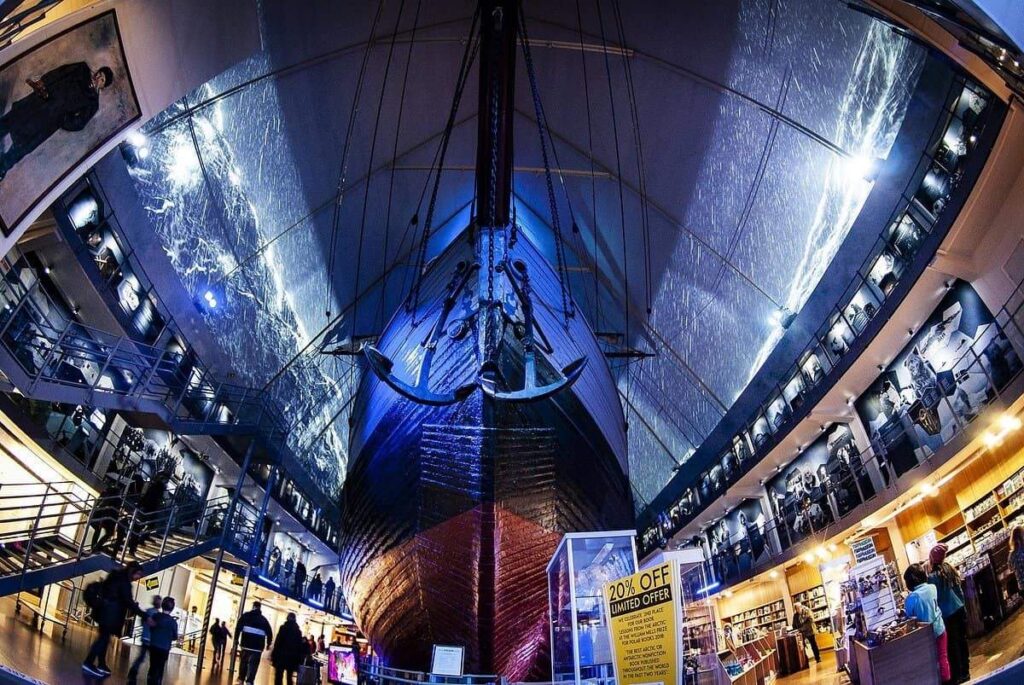
Located on the scenic Bygdøy Peninsula, the Fram Museum is one of Oslo’s most unique and captivating attractions. Dedicated to Norway’s legendary polar expeditions, the museum offers an immersive experience into the world of icy landscapes, heroic explorers, and groundbreaking maritime achievements. Whether you’re a history enthusiast, adventure seeker, or family traveler, the Fram Museum is a must-visit for anyone eager to uncover the spirit of exploration.
🌟 Highlights of the Fram Museum
🚢 The Fram – The Strongest Wooden Ship Ever Built
At the heart of the museum is the Fram itself—the famous polar ship that carried iconic Norwegian explorers like Fridtjof Nansen, Otto Sverdrup, and Roald Amundsen to the Arctic and Antarctic in the late 19th and early 20th centuries. Visitors can step aboard the original vessel, explore its cabins, engine room, and mess hall, and imagine life aboard during the world’s harshest expeditions.
🧭 Polar Exploration Exhibits
Engage with interactive displays, historical photographs, personal diaries, and authentic artifacts that tell the gripping tales of early polar exploration. Learn about the extreme conditions faced by explorers, their scientific contributions, and the international significance of Norway’s polar achievements.
❄️ Arctic and Antarctic Immersive Experience
Feel the chill of the polar regions in the museum’s cold room, experience a simulated storm, and see life-size animal models including polar bears and penguins. These features offer a hands-on, family-friendly way to understand the environments the Fram once braved.
🌍 Gjøa – The First Ship Through the Northwest Passage
Alongside the Fram, the museum also houses Gjøa, the ship used by Roald Amundsen on his historic voyage through the Northwest Passage. This part of the exhibit shines a spotlight on navigation, endurance, and Amundsen’s unmatched contributions to exploration history.
🚗 How to Get There
- By Ferry or Bus: Easily reachable via public transport from central Oslo—take the Bygdøy ferry in the summer or a local bus year-round.
- By Car or Bike: The museum offers parking and is a pleasant cycle from downtown along the Oslo waterfront.
🕒 Visitor Information
- Opening Hours: Open daily; hours vary by season.
- Admission: Tickets available online or at the entrance. Discounts for children, students, and families.
- Accessibility: The museum is wheelchair-friendly, and multilingual displays are available.
💡 Travel Tips
- 📷 Bring Your Camera – The museum offers stunning photo ops, especially aboard the Fram and Gjøa.
- ❄️ Dress in Layers – The cold room is an experience you don’t want to miss!
- 🎓 Perfect for All Ages – Engaging for children and enlightening for adults; it’s one of Oslo’s most educational museums.
The Fram Museum is more than just a museum—it’s a voyage into the past that honors Norway’s fearless polar pioneers. From climbing aboard the Fram to experiencing the icy grip of the Arctic, this museum combines storytelling, science, and adventure in an unforgettable way. It’s a place where history comes alive and visitors of all ages leave inspired by the bravery and brilliance of those who dared to explore the unknown.
Viking Ship Museum
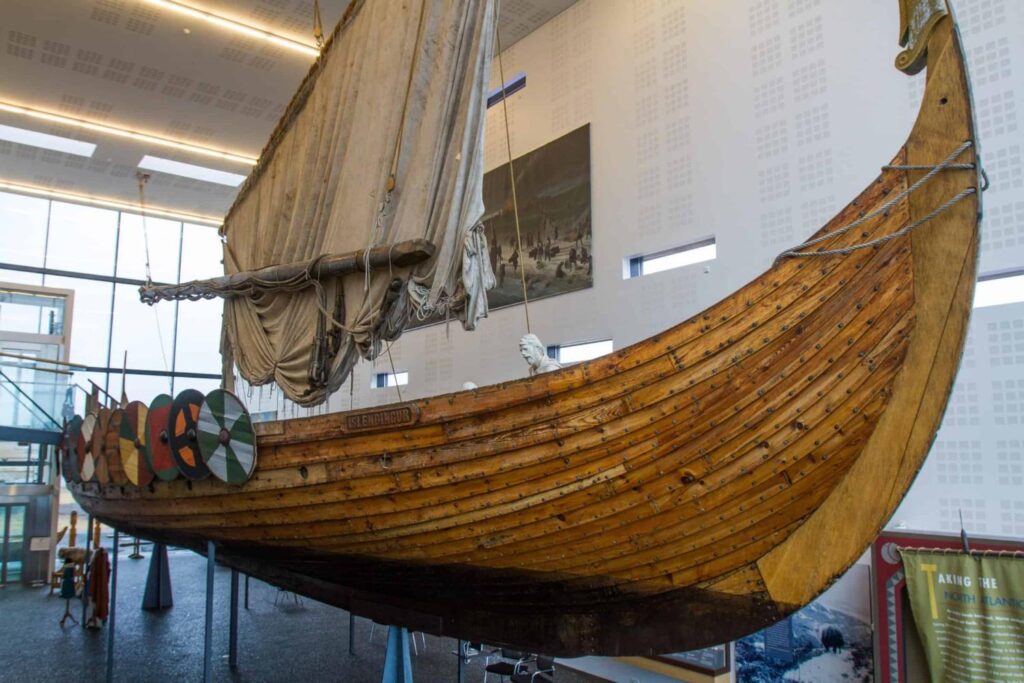
Step into the world of fierce seafarers, master shipbuilders, and ancient legends at the Viking Ship Museum in Oslo—officially reimagined as the Museum of the Viking Age. Located on the serene Bygdøy Peninsula, this iconic museum is home to the world’s best-preserved Viking ships and a treasure trove of burial artifacts. It’s a must-see destination for anyone intrigued by Norse culture, maritime history, and ancient craftsmanship.
🛠️ Please note: The museum is currently closed for renovation and is expected to reopen in 2027. In the meantime, selected artifacts are on display at the Museum of Cultural History in central Oslo.
🌟 Highlights of the Viking Ship Museum
🛶 The Oseberg Ship
Dating back to around 820 AD, the Oseberg ship is a masterpiece of Viking engineering. Discovered in a royal burial mound, it was the final resting place for two high-status women, buried alongside richly decorated sledges, textiles, wooden carvings, and even kitchen tools. The ship’s ornate prow is one of the most photographed Viking relics in the world.
🚢 The Gokstad Ship
Built for both sailing and rowing, the Gokstad ship is larger and sturdier than Oseberg’s. Thought to have belonged to a chieftain, it offers deep insights into Viking warfare and trade. It’s a testament to how advanced Norse naval design truly was, even over a thousand years ago.
⚓ The Tune Ship
Though less complete than the other two, the Tune ship—excavated in 1867—was the first Viking ship ever discovered in modern times. Its significance lies in its age and the clues it offers about Viking burial customs and shipbuilding techniques.
🪓 Artifacts & Exhibits
The museum doesn’t just stop at ships. You’ll also find:
- Intricate wood carvings
- Textiles and weaving tools
- Household items from the Viking Age
- Sleds, wagons, and even animal bones buried with the dead
These items paint a vivid picture of Viking daily life, spirituality, and the craftsmanship that defined the era.
🎥 A New Experience Coming Soon
The newly envisioned Museum of the Viking Age will feature cutting-edge exhibitions, immersive storytelling, and modern conservation techniques. Expect interactive displays, digital reconstructions, and dynamic presentations that bring Viking history to life like never before.
🚗 How to Get There
Current Location of Artifacts:
📍 Museum of Cultural History, University of Oslo (until 2027)
Public Transport: Trams and buses from Oslo city center
By Car: Limited parking near Bygdøy; consider public transport or bike rentals
🕒 Visitor Information
- Regular Hours: Daily (check the official website during renovations)
- Admission: Entry included with the Oslo Pass; discounts for students, seniors, and families
- Accessibility: Wheelchair accessible and family-friendly
- Time to Spend: 1–2 hours for exhibits; longer when reopened fully
💡 Travel Tips
- 📸 Photography is encouraged—the ships and artifacts make for stunning, dramatic shots.
- 🎧 Use the audio guide or join a tour for richer context.
- 🌦️ Pair your visit with other Bygdøy attractions like the Fram Museum or the Norwegian Folk Museum.
- 🧒 Great for families! Kids love the life-sized ships and engaging displays.
The Viking Ship Museum offers more than a history lesson—it’s a portal into the soul of Norway’s most legendary era. Whether you’re tracing your ancestry, indulging your love for Norse mythology, or simply marveling at ancient craftsmanship, this museum is an unforgettable experience.
Even during its transformation, the spirit of the Vikings lives on in every artifact and story told.
Karl Johans Gate
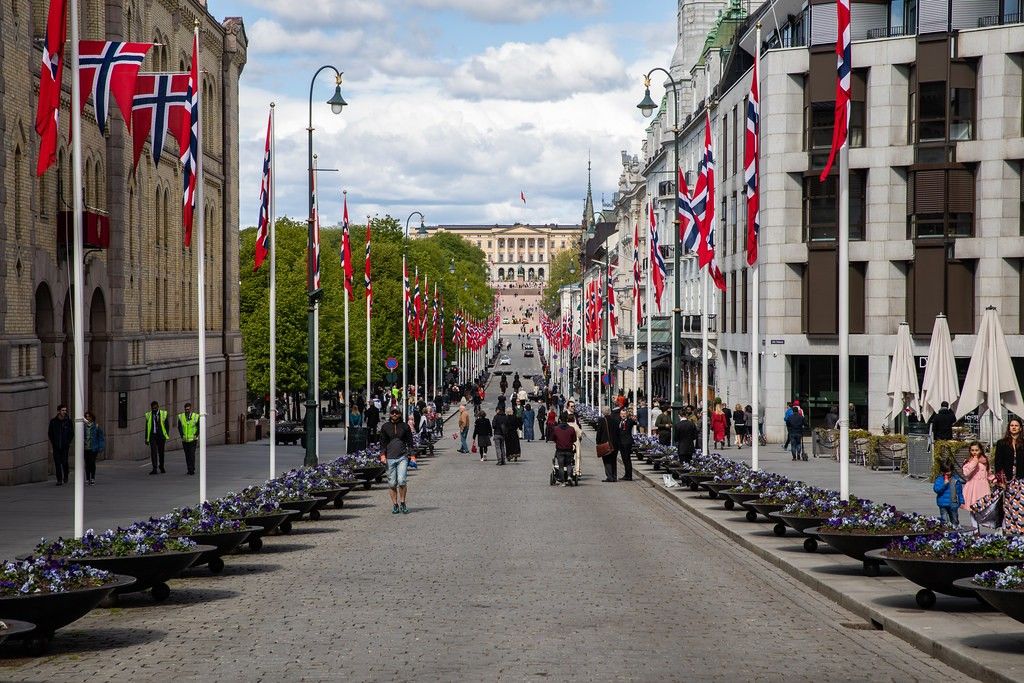
At the heart of Norway’s capital lies Karl Johans Gate, Oslo’s most famous and vibrant street. Stretching from the bustling Oslo Central Station to the regal Royal Palace, this historic avenue offers a dynamic blend of culture, shopping, dining, and sightseeing—all with a distinctly Scandinavian charm.
Whether you’re visiting for a casual stroll or planning to explore its many shops, museums, and historic landmarks, Karl Johans Gate is a quintessential stop for anyone discovering Oslo.
🌟 Highlights of Karl Johans Gate
🏛️ Royal Palace
Anchoring the western end of the street is the Royal Palace, home to Norway’s royal family. The palace grounds are open to the public year-round, and in summer, guided tours of the interior offer a peek into the elegant royal lifestyle. Don’t miss the changing of the guard ceremony, which draws visitors daily.
🚶 Oslo Central Station & Jernbanetorget
On the eastern end of Karl Johans Gate sits Oslo Central Station, the city’s main transportation hub. Just outside is Jernbanetorget, a lively square surrounded by cafes and modern architecture, often used for public events and live performances.
🛍️ Shopping & Boutiques
Karl Johans Gate is a shopper’s paradise, home to a wide variety of stores ranging from global brands like H&M and Zara to Norwegian specialty shops selling knitwear, books, and souvenirs. Side streets like Nedre Slottsgate are known for high-end shopping and designer labels.
🍽️ Cafes & Restaurants
Enjoy a coffee break at one of the charming sidewalk cafes, or indulge in traditional Norwegian cuisine at one of the many restaurants along the way. Popular spots include Café Sorgenfri and The Scotsman—both ideal for people-watching and soaking up the city vibe.
🎭 Cultural Institutions
Just off Karl Johans Gate, you’ll find major cultural landmarks such as:
- The National Theatre (home to Norwegian drama and classical performances)
- University of Oslo’s historic campus
- The Stortinget (Norwegian Parliament Building), open for tours and beautiful to photograph
📸 Don’t Miss These Photo Spots
- The tree-lined view from the Royal Palace steps
- The fountains and statues near Spikersuppa park
- The grand facade of the Parliament building
- Sunset or winter scenes with festive street lighting
🚇 How to Get There
- By Train: Oslo Central Station (Oslo S) is directly at one end of the street
- By Metro or Bus: Multiple stops line the route, including Stortinget Station
- On Foot: The entire street is walkable and pedestrian-friendly
🕒 Best Time to Visit
- Spring & Summer: Street performers, blooming flowers, and open-air cafes
- Winter: Holiday lights, Christmas markets, and festive atmosphere
- Evening: Lit-up buildings and nightlife come alive along the strip
💡 Travel Tips
- 👟 Wear comfortable shoes—you’ll be walking and browsing for hours
- 📆 Check for local events or parades, especially on national holidays
- 🛍️ Look for Norwegian brands—like Dale of Norway or Moods of Norway—for unique souvenirs
- 🍦 Try local snacks, like softis (soft-serve ice cream) or a kanelbolle (cinnamon bun)
Karl Johans Gate is more than just a street—it’s a living, breathing expression of Oslo’s identity. It’s where history meets modern life, and where visitors can experience the city’s pulse in real time. Whether you’re here to shop, sightsee, or simply wander, this bustling boulevard belongs on every Oslo itinerary.
Munch Museum
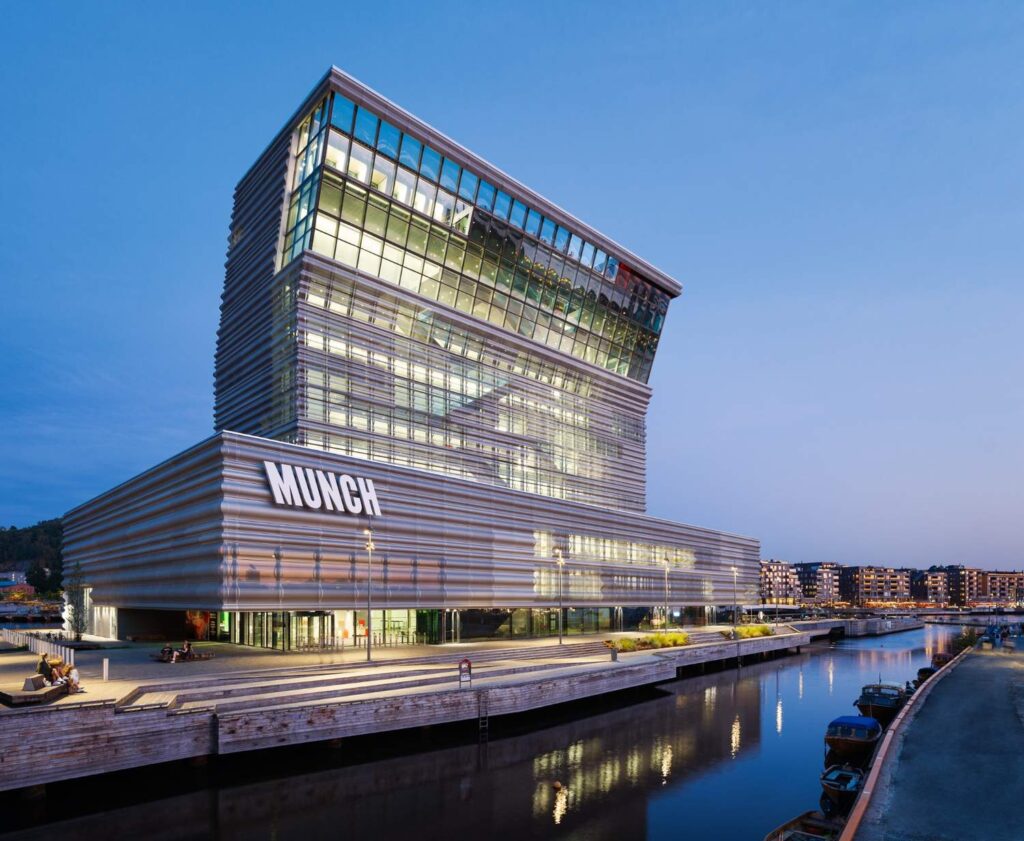
Located in the heart of Oslo’s vibrant Bjørvika district, the Munch Museum (also known as MUNCH) is a striking modern tribute to one of the world’s most influential artists, Edvard Munch. Known for masterpieces like The Scream and Madonna, Munch’s emotionally charged and visionary work has left an indelible mark on modern art. A visit to this museum offers not just a glimpse into Munch’s genius, but a full sensory journey through his turbulent, expressive world.
🖼️ Highlights of the Munch Museum
🎨 A Vast Collection of Munch’s Work
MUNCH houses over 28,000 pieces of Edvard Munch’s art, making it the largest collection of his work in the world. From iconic paintings like The Scream, The Dance of Life, and The Sick Child to lesser-known sketches, photographs, and personal letters, the museum offers a comprehensive look into his life and legacy.
🏙️ Stunning Architecture & Waterfront Views
The museum’s bold, high-rise design is a landmark in itself. Overlooking Oslo’s scenic fjord, the building offers panoramic views from its upper floors. The design, by Spanish architects Estudio Herreros, reflects Munch’s intense emotional expression with its tilted structure and dramatic verticality.
🧠 Immersive & Interactive Exhibits
MUNCH is more than just a gallery—it’s a cultural experience. Multimedia installations, soundscapes, films, and virtual tours enhance your understanding of Munch’s work and psyche. Exhibits explore themes like love, anxiety, death, and the human condition—all central to Munch’s artistic journey.
🎭 Rotating Exhibitions & Contemporary Art
In addition to Munch’s own works, the museum features temporary exhibitions showcasing Norwegian and international contemporary artists influenced by Munch’s style and themes. This keeps the museum experience dynamic and engaging for returning visitors.
☕ Amenities & Extras
- Top-floor Restaurant & Bar: Enjoy Nordic cuisine and craft cocktails with a view of the Oslo fjord.
- Gift Shop: Find unique Munch-themed prints, books, and design items.
- Workshops & Talks: The museum regularly hosts creative workshops, guided tours, and lectures for all ages.
🕒 Visitor Information
- Location: Bjørvika, right next to the Oslo Opera House and Oslo Central Station.
- Opening Hours: Open daily, usually from 10 AM to 9 PM (subject to seasonal changes).
- Tickets: Can be purchased online or on-site. Discounts available for students, children, and seniors.
- Accessibility: Fully wheelchair-accessible with elevators and adapted restrooms.
🚶 How to Get There
- By Foot: A short 5-minute walk from Oslo Central Station.
- By Public Transport: Easily accessible via tram, bus, and metro to Jernbanetorget or Bjørvika stops.
- By Bike/Scooter: Ample bike parking outside and e-scooter availability throughout the area.
💡 Travel Tips
- 🎧 Use the Audio Guide – Available in multiple languages to deepen your understanding of Munch’s symbolism and personal struggles.
- 📸 Don’t Miss the Photo Spots – Especially the viewing platform on the top floor and the glass walls framing Oslo’s skyline.
- 🕰️ Visit Early or Late – Avoid crowds by coming early in the morning or in the evening hours.
- 🛍️ Shop Thoughtfully – The gift shop is one of Oslo’s best places for artistic souvenirs.
The Munch Museum is more than a gallery—it’s an emotional and artistic journey into the mind of one of Norway’s greatest icons. Whether you’re an art lover or simply curious about the origins of The Scream, MUNCH invites you to reflect, feel, and connect with art in an intimate and unforgettable way. It’s a must-see cultural experience in Oslo that resonates long after your visit.
Holmenkollen Ski Jump

Towering high above the city, the Holmenkollen Ski Jump isn’t just a marvel of modern architecture—it’s a symbol of Norway’s deep-rooted love for skiing and winter sports. Located just a short ride from downtown Oslo, Holmenkollen offers an unforgettable mix of adrenaline, history, and panoramic views that stretch across the Oslofjord.
Whether you’re a sports enthusiast, a history buff, or a traveler seeking jaw-dropping vistas, a visit to Holmenkollen is a must on your Oslo itinerary.
🌟 Highlights of Holmenkollen Ski Jump
🏔️ The Ski Jump Tower
One of the most famous ski jumps in the world, the current structure was completed in 2010 and is used for international competitions, including the FIS World Cup. Standing at 64 meters tall, it features a sleek, futuristic design that lights up beautifully at night.
🌄 Observation Deck: Take the elevator to the top of the jump tower for breathtaking 360° views of Oslo, the fjord, and surrounding forests. On clear days, you can see for miles!
🏛️ Holmenkollen Ski Museum
Located beneath the jump, this is the world’s oldest ski museum, opened in 1923. It tells the story of 4,000 years of skiing history, from Viking-era skis to modern Olympic equipment. You’ll also find exhibits on polar exploration, including artifacts from Roald Amundsen’s expeditions.
🎮 Ski Simulator
Looking for a thrill without hitting the slopes? The Holmenkollen ski simulator gives you the sensation of ski jumping at high speeds—without leaving the ground! It’s a fun, family-friendly way to experience the rush.
❄️ Seasonal Activities
- Winter: Come during snow season to watch ski competitions or try cross-country skiing in the surrounding trails.
- Summer: Enjoy hiking, biking, and picnicking in Nordmarka forest just behind the jump.
- Christmas Time: A festive market and snowy views make Holmenkollen a winter wonderland.
📍 How to Get There
- By Metro: Take Line 1 (Frognerseteren) from Oslo Central Station to Holmenkollen Station. From there, it’s a short uphill walk to the ski jump.
- By Car: Free or paid parking available near the site (note: limited during events).
🕒 Visitor Information
- Opening Hours: Vary seasonally—check the official website for current times.
- Admission Fees:
- Adults: Approx. NOK 160
- Children/Seniors/Students: Discounted rates
- Oslo Pass holders: Free entry
- Time Needed: Plan for 1.5 to 2.5 hours, especially if you’re visiting the museum and tower.
💡 Travel Tips
- 📷 Bring your camera—the views from the top are some of the best in Oslo!
- 🧥 Dress in layers, especially in colder months, as the wind can be strong at the top.
- ☕ Stop by the café near the museum for coffee and pastries with a view.
- 📅 Visit early or late in the day for fewer crowds and softer lighting for photography.
The Holmenkollen Ski Jump is more than just a sports venue—it’s a piece of Norwegian identity. From its legendary past to its high-tech present, it captures the thrill of skiing, the beauty of Oslo’s landscape, and the spirit of adventure that defines Norway. Whether you’re gazing from the top of the tower or exploring the museum below, Holmenkollen promises a memorable experience in any season.
Bygdøy Peninsula
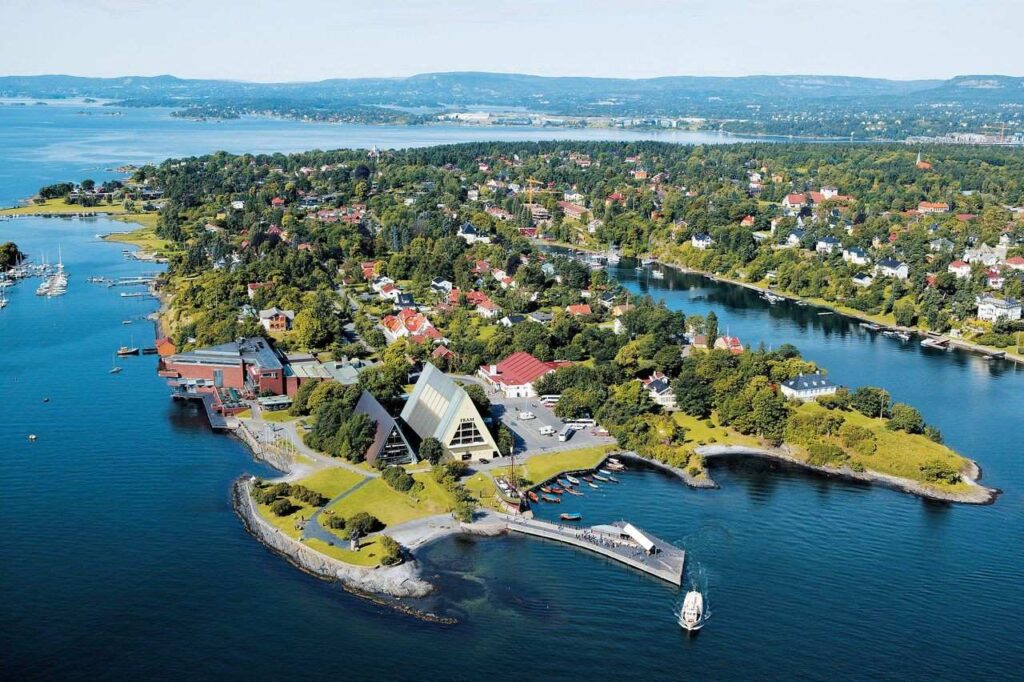
Just a short ride from the city center, the Bygdøy Peninsula is one of Oslo’s most beloved destinations—a perfect blend of rich history, world-class museums, serene nature, and coastal charm. Whether you’re a history buff, museum lover, beachgoer, or just seeking a peaceful escape, Bygdøy offers a unique experience that showcases the best of Norwegian culture and nature in one beautiful setting.
🌟 Top Attractions on Bygdøy
🛶 Viking Ship Museum (Temporarily Closed for Renovation)
One of the peninsula’s most famous sites, the Viking Ship Museum houses some of the world’s best-preserved Viking ships and artifacts. Though currently under renovation until its reopening as the Museum of the Viking Age, it remains a must-see once completed, offering an unforgettable look into Norway’s seafaring past.
🚢 Fram Museum
Step aboard the legendary Fram, the world’s strongest wooden ship, used in historic Arctic and Antarctic expeditions. Learn about explorers like Fridtjof Nansen and Roald Amundsen and get a real sense of what life was like aboard during extreme polar voyages.
🌍 Kon-Tiki Museum
Explore the daring adventures of Thor Heyerdahl, who crossed the Pacific Ocean on a handmade raft. The museum displays the original Kon-Tiki raft, as well as artifacts from his expeditions and films that bring his explorations to life.
🐬 Norwegian Maritime Museum
For maritime history fans, this museum dives into Norway’s deep-rooted relationship with the sea—from fishing and shipping to naval traditions and Arctic exploration.
🐾 Norwegian Museum of Cultural History (Norsk Folkemuseum)
This open-air museum showcases Norwegian life across centuries with over 150 historic buildings, including a striking Gol Stave Church from the 13th century. With costumed guides, folk dances, and craft demonstrations, it’s a favorite for families and history lovers alike.
🏖️ Nature & Outdoor Experiences
Bygdøy isn’t just about museums—it’s also a haven for outdoor lovers.
🌲 Bygdøy Royal Estate & Forest Trails
Once a royal farm, this peaceful area is still used by the royal family and is surrounded by walking trails perfect for hikes or bike rides through forested areas and along the fjord.
🏖️ Paradisbukta & Huk Beaches
On warm days, locals and tourists alike flock to Huk Beach and the more secluded Paradisbukta for sunbathing, swimming, or relaxing by the water. Pack a picnic and enjoy the coastal scenery just minutes from Oslo’s city center.
🚗 How to Get There
- By Ferry (Seasonal): From Aker Brygge (Pier 3), a 15-minute ferry ride whisks you across the fjord to Bygdøy (runs from April to October).
- By Bus: Year-round bus #30 goes directly from Oslo city center to most of Bygdøy’s museums.
- By Bike: A scenic, easy ride along the harbor takes around 20 minutes from downtown Oslo.
- By Car: Parking is available near the museum area, but spaces can be limited during peak season.
🕒 Visitor Tips
- ⏰ Plan a Half to Full Day: With so much to see and do, you’ll want at least half a day—ideally a full day—to explore.
- 🧺 Bring Snacks or Picnic: While some cafes are on-site, bringing food lets you enjoy a peaceful lunch in nature or by the beach.
- 🎟️ Museum Pass: Oslo Pass holders get free admission to most museums on Bygdøy and can use public transport and ferries at no extra cost.
- 📷 Bring a Camera: Between the traditional buildings, fjord views, and Viking ships, there are photo ops at every turn.
The Bygdøy Peninsula is where Oslo’s rich heritage meets natural beauty. Whether you’re soaking up Viking history, wandering forest trails, or relaxing by the water, Bygdøy offers a refreshing contrast to urban Oslo without ever feeling far away. It’s a must-visit for those who want to experience the cultural heart and serene soul of Norway in one unforgettable day.
Oslo Fjord Cruises
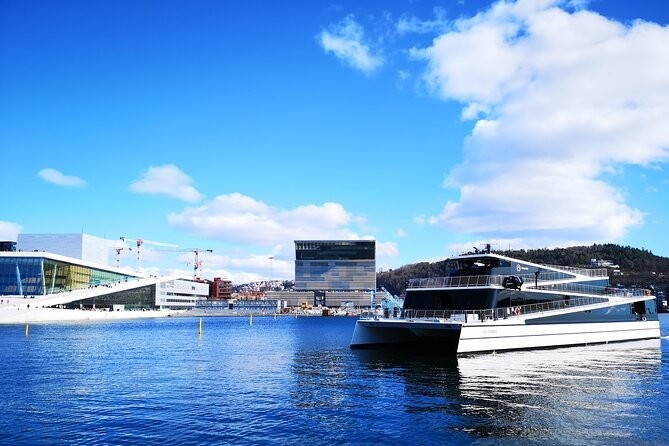
Set sail through serene waters, charming islands, and Nordic landscapes with an Oslo Fjord Cruise—one of the most relaxing and picturesque ways to experience the capital of Norway. Whether you’re a first-time visitor or a returning traveler, cruising the Oslofjord offers a unique perspective of the city and its surrounding nature.
From sunset sailings to historical island tours, there’s a cruise for every traveler looking to soak up the beauty of Oslo from the water.
🌟 Highlights of an Oslo Fjord Cruise
🌊 Stunning Scenery
The Oslofjord isn’t a deep fjord like those in Western Norway, but it’s equally enchanting. Expect a peaceful blend of wooded islands, rocky coves, waterfront cabins, and sailboats gliding across the water.
Popular sights from the boat include:
- Akershus Fortress
- The Opera House from the water
- Bygdøy Peninsula with its famous museums
- Dyna Lighthouse and other photogenic islets
🏝️ Island Hopping Adventures
Many cruises offer hop-on, hop-off options, letting you explore islands like Hovedøya, Lindøya, or Gressholmen—ideal for nature walks, swimming, or picnicking in summer. Ferries to these islands are part of the public transport network too!
🌅 Sunset & Jazz Cruises
For something special, book an evening cruise with a live jazz band or a traditional shrimp buffet. These 2-hour trips are perfect for couples or those looking to end the day with great food and atmosphere on the water.
❄️ Winter Cruises
Yes, you can cruise the Oslofjord even in winter! Enclosed boats with warm interiors and panoramic windows provide a cozy way to view the frosty fjord and snow-covered shoreline.
🚤 Types of Cruises
- Sightseeing Cruises (1.5–2 hours): Ideal for first-timers
- Island Hopping Cruises: Explore hidden gems with flexible stops
- Dinner or Jazz Cruises: Food, music, and sunset views
- Private Boat Rentals: For small groups, events, or photo tours
- RIB Boat Tours: High-speed adventure for thrill-seekers
📍 Departure Points
Most cruises depart from Rådhusbrygge (City Hall Pier), near the Oslo City Hall and Aker Brygge area. It’s easily accessible on foot or via public transport.
🕒 Practical Info
- Best Time to Cruise:
- May–September for warm weather and full service
- Winter cruises offer fewer departures but magical snowy scenery
- Tickets:
- Prices range from NOK 300–600 depending on duration and inclusions
- Book online in advance during peak season
- Oslo Pass: May include discounts on certain sightseeing cruises
💡 Travel Tips
- 📸 Bring your camera or phone—sunsets and city views are stunning from the water
- 🧥 Dress in layers even in summer; it’s cooler on the fjord
- 🕶️ Choose a seat outside on sunny days, or near the window for indoor comfort
- 🚿 Bring swimwear and a towel if you’re island-hopping in summer—locals love taking a dip!
An Oslo Fjord Cruise is more than just a boat ride—it’s a chance to disconnect, breathe in fresh air, and take in Oslo’s natural charm from a new vantage point. Whether you’re watching the sunset over the city skyline or exploring tiny green islands that feel miles away from urban life, the Oslofjord invites you to slow down and savor every moment.
📝 Local Travel Tips
- 🎫 Buy an Oslo Pass: It offers free public transport and discounts on many attractions.
- 🧥 Dress in layers: Weather can be unpredictable; layering helps you stay comfortable year-round.
- ☕ Try Norwegian cuisine: Sample fresh seafood, brunost (brown cheese), and local pastries like skolebrød.
- 🌲 Explore nature: Oslo’s green spaces and nearby forests make it easy to enjoy hiking and outdoor activities.
- 🕰️ Plan for daylight: During winter, daylight is limited, so schedule outdoor sightseeing accordingly.
📌 Additional Information
- Safety: Oslo is one of Europe’s safest capitals but always stay aware in crowded places.
- Connectivity: Free Wi-Fi is common in cafés and public spots; local SIM cards are easy to get.
- Shopping: Pick up Norwegian wool clothing, handcrafted souvenirs, and local design items.
- Cultural Respect: Norwegians value personal space and politeness — a friendly “hei” (hi) and “takk” (thank you) go a long way.
✨ Final Thoughts
Oslo is a captivating city where history, culture, and nature come together in perfect harmony. From walking on the iconic Opera House roof to immersing yourself in Viking lore or cruising the stunning fjord, Oslo offers a rich tapestry of experiences. Whether you visit in summer’s endless light or winter’s cozy embrace, this Scandinavian gem will leave you inspired and refreshed.
Pack your bags for Oslo — an unforgettable blend of urban excitement and natural beauty awaits! 🌲🏙️🚤
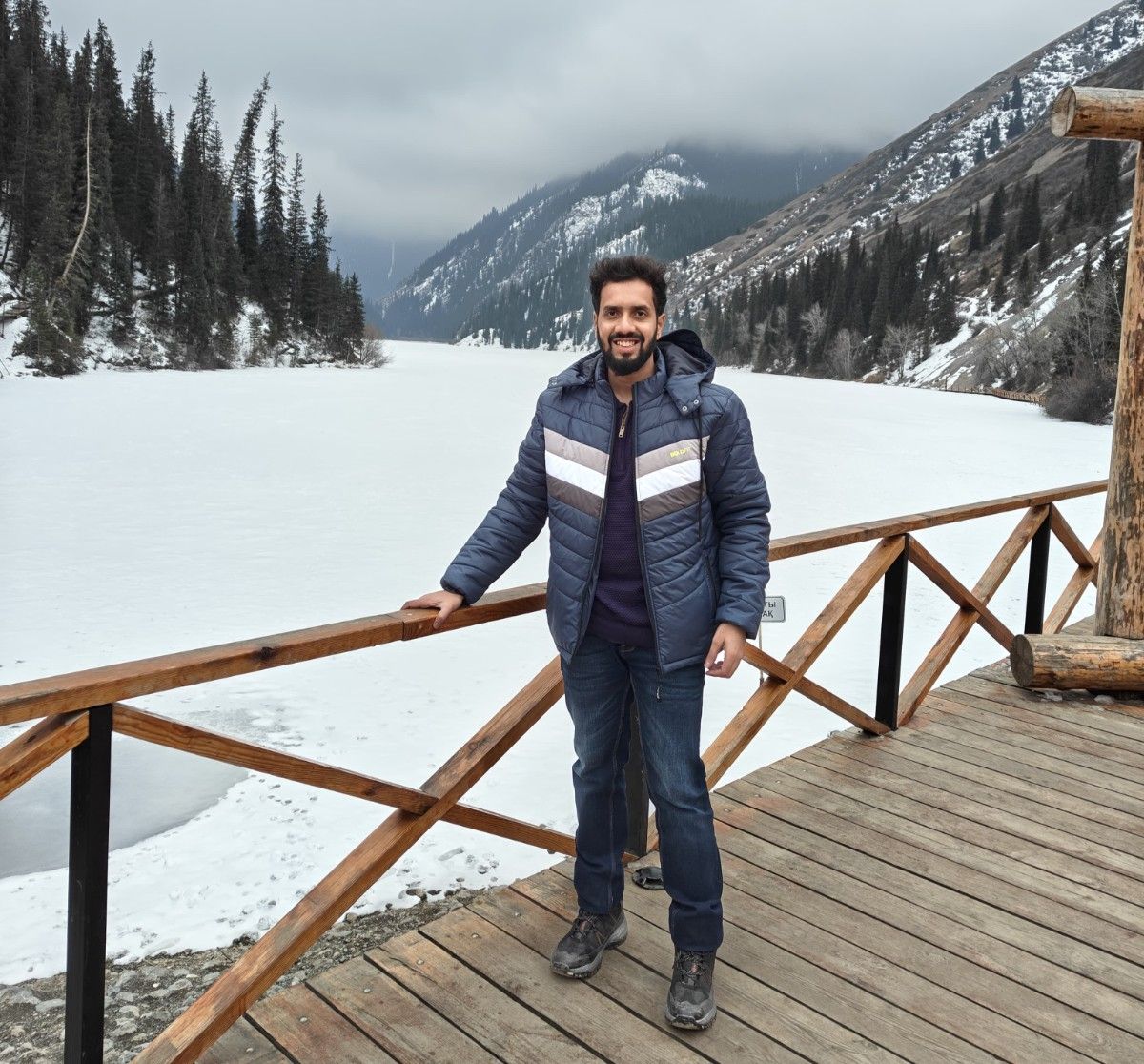
I’m Shreyash Mhashilkar — a full-stack developer by profession, and a passionate explorer of the future at heart.
With a strong foundation in both front-end and back-end , I spend my days building websites and applications that are not just functional, but scalable, intuitive, and user-focused.




